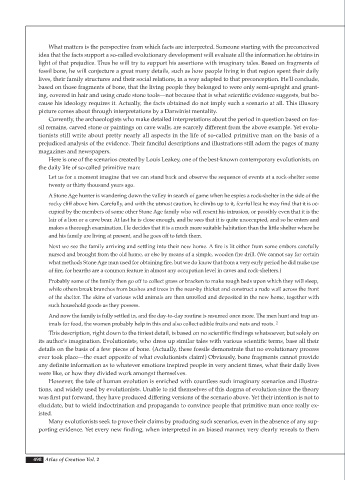Page 500 - Atlas of Creation Volume 2
P. 500
What matters is the perspective from which facts are interpreted. Someone starting with the preconceived
idea that the facts support a so-called evolutionary development will evaluate all the information he obtains in
light of that prejudice. Thus he will try to support his assertions with imaginary tales. Based on fragments of
fossil bone, he will conjecture a great many details, such as how people living in that region spent their daily
lives, their family structures and their social relations, in a way adapted to that preconception. He'll conclude,
based on those fragments of bone, that the living people they belonged to were only semi-upright and grunt-
ing, covered in hair and using crude stone tools—not because that is what scientific evidence suggests, but be-
cause his ideology requires it. Actually, the facts obtained do not imply such a scenario at all. This illusory
picture comes about through interpretations by a Darwinist mentality.
Currently, the archaeologists who make detailed interpretations about the period in question based on fos-
sil remains, carved stone or paintings on cave walls, are scarcely different from the above example. Yet evolu-
tionists still write about pretty nearly all aspects in the life of so-called primitive man on the basis of a
prejudiced analysis of the evidence. Their fanciful descriptions and illustrations still adorn the pages of many
magazines and newspapers.
Here is one of the scenarios created by Louis Leakey, one of the best-known contemporary evolutionists, on
the daily life of so-called primitive man:
Let us for a moment imagine that we can stand back and observe the sequence of events at a rock-shelter some
twenty or thirty thousand years ago.
A Stone Age hunter is wandering down the valley in search of game when he espies a rock-shelter in the side of the
rocky cliff above him. Carefully, and with the utmost caution, he climbs up to it, fearful lest he may find that it is oc-
cupied by the members of some other Stone Age family who will resent his intrusion, or possibly even that it is the
lair of a lion or a cave bear. At last he is close enough, and he sees that it is quite unoccupied, and so he enters and
makes a thorough examination. He decides that it is a much more suitable habitation than the little shelter where he
and his family are living at present, and he goes off to fetch them.
Next we see the family arriving and settling into their new home. A fire is lit either from some embers carefully
nursed and brought from the old home, or else by means of a simple, wooden fire drill. (We cannot say for certain
what methods Stone Age man used for obtaining fire, but we do know that from a very early period he did make use
of fire, for hearths are a common feature in almost any occupation level in caves and rock-shelters.)
Probably some of the family then go off to collect grass or bracken to make rough beds upon which they will sleep,
while others break branches from bushes and trees in the near-by thicket and construct a rude wall across the front
of the shelter. The skins of various wild animals are then unrolled and deposited in the new home, together with
such household goods as they possess.
And now the family is fully settled in, and the day-to-day routine is resumed once more. The men hunt and trap an-
imals for food, the women probably help in this and also collect edible fruits and nuts and roots. 2
This description, right down to the tiniest detail, is based on no scientific findings whatsoever, but solely on
its author's imagination. Evolutionists, who dress up similar tales with various scientific terms, base all their
details on the basis of a few pieces of bone. (Actually, these fossils demonstrate that no evolutionary process
ever took place—the exact opposite of what evolutionists claim!) Obviously, bone fragments cannot provide
any definite information as to whatever emotions inspired people in very ancient times, what their daily lives
were like, or how they divided work amongst themselves.
However, the tale of human evolution is enriched with countless such imaginary scenarios and illustra-
tions, and widely used by evolutionists. Unable to rid themselves of this dogma of evolution since the theory
was first put forward, they have produced differing versions of the scenario above. Yet their intention is not to
elucidate, but to wield indoctrination and propaganda to convince people that primitive man once really ex-
isted.
Many evolutionists seek to prove their claims by producing such scenarios, even in the absence of any sup-
porting evidence. Yet every new finding, when interpreted in an biased manner, very clearly reveals to them
498 Atlas of Creation Vol. 2

